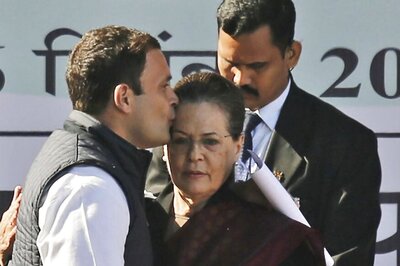
views
New Delhi: A spring in the Hindu goddess Ragnya Devi temple at khirbhawani, about 27 km from Srinagar, the summer capital of Jammu and Kashmir, changes its colours from time to time.
It takes on various hues like red, pink, orange, green, blue and has often light green, red rosy and milky white shades.
It is being said that the colour of the spring remained black in the year 1947 when the Pakistani raiders attacked the Kashmir valley.
Any shade of black colour is supposed to be inauspicious for the inhabitants of the valley, said the Kashmir pandit priests.
They said many times rising of bubbles has been observed which form the mystic Chakra on the surface of the water.
Such a sacred and mysterious spring is not found elsewhere in India. The people living round the holy spring have great veneration for the holy shrine as nobody enters the premises of the holy spring if he happens to have taken meat on that day.
The spring, dedicated to Goddess Khir Bhawani, has an irregular septagonal shape with its apex called Pad (feet) to the East. The northern and the southern sides are longer than the western side which is called Shir (Head). In the centre of the holy spring where once stood a mulberry tree, there is one marble temple which enshrines some idols found at the time of cleansing the spring.
In early 1970 an electric pump was installed to conduct the cleansing operation of the spring. Besides removal of mud and mire which had accumulated since long at the bottom of the spring a number of gold ornaments and silver pieces offered to the Goddess were recovered.
As a result of the silt clearance a huge volume of milky white water bubbled out.
Various legends and stories are current among the people regarding the holy spring. One such legend is that when Ravana was killed at the hands of Bagwan Rama the Goddess Bhawani ordered Hanuman to carry her to Satisar-Kashmir along with 360 Nagas.
Hanuman selected the site and installed the Goddess in the Northern part of the valley. She came to be known as Khir Bhawani or Ragyna Bhagwati as her favourite offerings consist of rice cooked in milk and sugar, and all other vegetarian forms of diet.
They said there is also an interesting story about how this spring came to light among the people.
It is related that one pious Brahmin named Krishna Pandit of old city Habba Kadal had a vision wherein he was informed by a Deva to offer Puja to Khir Bhawani in the swamps of Tullamulla.
Pandit was guided by a snake through the swampy and marshy land, until he reached the hollow trunk of a mulberry tree.
The saint took the clue and after performing Puju poured milk which he had brought for this purpose. It is thus that the holy spring was discovered and was known to Kashmiries.
It is believed that the discovery of the holy spring has been made on Ashadha Saptami, the 7th day of the bright fortnight of the month of June-July. Kashmiri Hindus come here on every Ashtami - 8th day of the bright fortnight of each lunar month and majority of Kashmiri Hindus consider Khir Bhawani as their guardian Goddess.
The annual festival is held on Jesht Ashtami (May-June) when Kashmir pandits visit the place in large numbers to offer prayers to seek the blessings of the diety.
Devotees also throng on every Shukla Paksh Ashtami round the year and perform HAWANS to please the Mother.
The historic Temple of Kheer Bhiwani was built by Maharaja Pratap Singh in 1912 and later renovated by Maharaja Hari Singh.
The diety of Godess Ragyna is decorated in a small white Marble Temple. The legend goes that Lord Rama worshiped Mother Ragyna during his exile and desired Hanuman ji to shift the seat of Mother after the expiry of exile period, who bought it to Shadipora and was latter shifted to present to present site as per the wish of divine Mother Ragnya conveyed in dream to one Pandit Rugnath Gadroo, it is believed.
Thousands of Kashmiri pandits used to visit the temple on Khir Bhawani Mela.
However, after migration of Pandits from the Kashmir valley in early 90s, only few hundreds were visiting the temple till late 90s.
But during the past one decade, the number of Pandits, coming from different parts of the country, started increasing with every passing year.
In 2010 it was more than one lakh as per the organisers of the Mela, which has now become a source of reunion among the local Muslims and Pandits, who had migrated from the valley.
The state government has constructed a number of rooms for the devotees, who are coming to temple from outside the Kashmir valley.

















Comments
0 comment